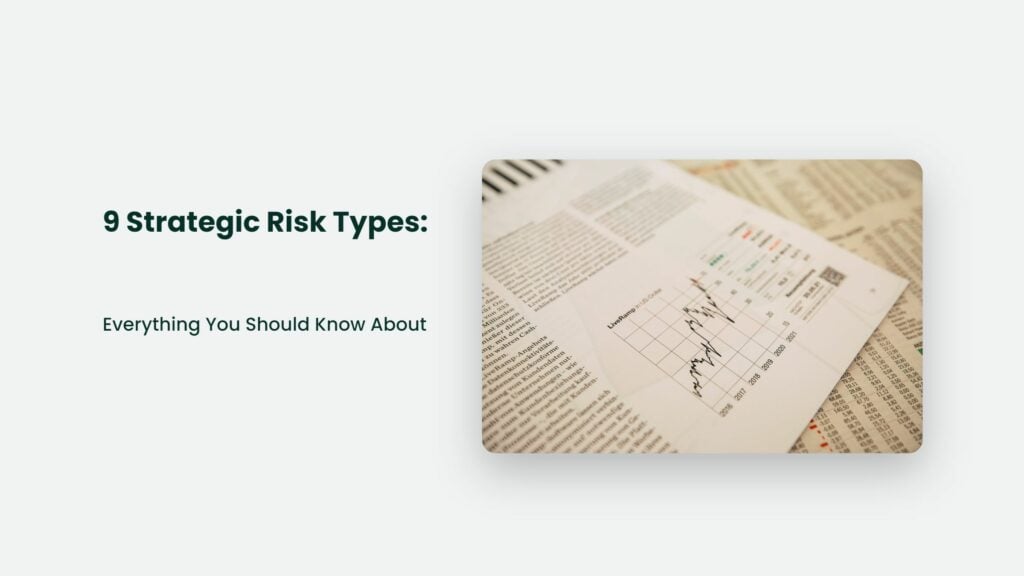When it comes to running a successful business, taking chances is an essential part of the process. There is, however, a certain level of risk involved in any activity associated with the company.
Strategic risk management helps to identify potential threats and mitigate their effects. Understanding strategic risk types can be critical for maintaining success for your organization.
From financial and operational risks to compliance and legal challenges, we’ll look at nine types of strategic risks and discuss strategies on how best to protect against them.
Table of Contents

What is Strategic Risk?
Strategic risk is inevitable in running any business, large or small. It involves identifying potential risks to a company’s organization, operations, and long-term goals and establishing processes for minimizing and mitigating those risks. Strategic risk can involve internal issues, such as changes in the industry or external issues, such as natural disasters that cause destruction to the company’s infrastructure.
It is important for organizations to evaluate the potential impacts of strategic risks to craft effective solutions that minimize the damage. Strategies can vary from monitoring technologies and forecasting changes in the competitive landscape to having contingency plans ready for quickly responding to various situations. With well-formed strategies for addressing strategic risk, businesses can remain competitive in precarious environments.
Strategic Risk Management
Strategic risk management is identifying, assessing, and prioritizing risks that may impact a company’s ability to achieve its strategic objectives and then developing and implementing strategies to manage those risks.
The goal of strategic risk management is to enable organizations to make informed decisions and achieve their goals, while minimizing the impact of potential risks and uncertainties.
The strategic risk management process typically includes the following steps:
- Identification: This involves identifying the most relevant risks to the organization’s strategic objectives. This can be done through internal assessments, market research, industry analysis, and other forms of data gathering.
- Assessment: This involves evaluating each identified risk’s likelihood and potential impact. This helps to prioritize the risks and determine which ones require the most attention.
- Prioritization: This involves ranking the risks based on their likelihood and potential impact and determining which ones are the most critical to address.
- Mitigation: This involves developing and implementing strategies to manage the risks that have been prioritized. This may include implementing new systems, processes, or controls; transferring the risk to another party through insurance or other financial instruments; or avoiding the risk altogether by changing the company’s strategy.
- Monitoring and Review: This involves regularly monitoring the effectiveness of the risk management strategies and making adjustments as needed. This helps ensure the risk management process remains relevant and effective over time.
Strategic risk management is an ongoing process that requires continuous monitoring, review, and adjustment. By having a robust risk management process in place, organizations can minimize the impact of potential risks and uncertainties and achieve their strategic objectives with greater confidence.
Understanding the Strategic Risk Types:
Understanding the different types of strategic risk is an important part of effective risk management. By identifying the specific risks that are most relevant to your organization, you can develop targeted strategies to manage them and minimize their impact.
The following are some of the most common strategic risk types:
Market Risk
Market risk is a type of strategic risk that refers to the uncertainty of demand for a company’s products or services. It can arise from various factors, including consumer behaviour changes, new market competition, or economic downturns. Market risk can significantly impact a company’s finances, resulting in lower sales, reduced profit margins, and increased financial volatility.
For example, a company specialising in selling a particular product may experience market risk if there is a sudden decline in demand for that product due to changes in consumer preferences or the introduction of new products into the market.
Similarly, a company that operates in a highly competitive industry may experience market risk if new competitors enter the market and increase competition, leading to lower sales and profit margins.
Governance Risk
Governance risk is the risk of harm to an organization’s reputation, finances, or operations due to poor governance practices. This risk can arise from various factors, including ineffective leadership, inadequate internal controls, and a lack of transparency and accountability.
Good governance practices are essential for organizations of all sizes and types, as they help ensure that the organization is run effectively, efficiently, and ethically. On the other hand, poor governance practices can result in a range of negative consequences, including increased risk of fraud and corruption, decreased public trust and confidence, and lower financial performance.
Political Risk
Political risk is a type of strategic risk that refers to the uncertainty and potential consequences of political events, policies, and actions. Political risk can impact a company’s operations, finances, and reputation and can arise from various factors, including government policies, political instability, and conflicts.
Examples of political risks include changes in tax laws, tariffs, and trade restrictions; changes in labour laws; and nationalization or expropriation of assets. Political risk can also arise from wars, political uprisings, and natural disasters.
Regulatory Risk:
Regulatory risk is a type of strategic risk that refers to the risk of non-compliance with laws and regulations, which can result in fines, legal action, or damage to a company’s reputation. This type of risk can arise from various factors, including changes in laws and regulations and a failure to comply with existing regulations.
For example, a company may experience regulatory risk if it operates in an industry that is heavily regulated and it fails to comply with the regulations that govern that industry. This could result in fines, legal action, or damage to the company’s reputation, which could significantly impact its finances and operations.
Financial Risk
Financial risk is a type of strategic risk that refers to the uncertainty of financial performance and the potential for financial loss. It can arise from various factors, including fluctuations in exchange rates, interest rates, or commodity prices, as well as changes in market conditions and economic trends. Financial risk can have a significant impact on a company’s finances, as it can result in reduced profits, increased debt, and decreased financial stability.
For example, a company operating in a highly competitive industry may experience financial risk if market conditions change, leading to reduced demand for its products or services. Similarly, a company heavily dependent on a particular commodity may experience financial risk if the price of that commodity fluctuates, resulting in reduced profits.

Competitive Risk:
Competitive risk is a type of strategic risk that refers to the risk of harm to a company’s reputation, finances, or market position due to increased competition. This risk can arise from various factors, including new competitors entering the market, changes in consumer preferences, or technological advancements that disrupt the industry.
For example, a company that operates in a highly competitive industry may experience competitive risk if new competitors enter the market and increase competition, leading to lower sales and profit margins. Similarly, a company specialising in a particular product or service may experience competitive risk if changes in consumer preferences result in decreased demand for that product or service.
Operational Risk:
Operational risk is a type of strategic risk that refers to the risk of loss due to operational failures, such as a systems malfunction or human error. It can arise from various factors, including inadequate systems, processes, controls, employee training, or external events like natural disasters or cyber-attacks. Operational risk can have a significant impact on a company’s finances, as it can result in reduced productivity, increased costs, and reputational damage.
For example, a company may experience operational risk if its IT systems experience a major failure, resulting in lost data or disrupted operations. Similarly, a company may experience operational risk if its employees are not adequately trained, leading to mistakes or errors in their work.
Operational Risk:
Economic risk is a type of strategic risk that refers to the uncertainty of financial performance and the potential for financial loss due to changes in economic conditions. This type of risk can arise from various factors, including fluctuations in exchange rates, interest rates, or commodity prices, as well as changes in market conditions and economic trends. Economic risk can have a significant impact on a company’s finances, as it can result in reduced profits, increased debt, and decreased financial stability.
For example, a company may experience economic risk if a recession or economic downturn leads to reduced demand for its products or services. Similarly, a company that operates in a country with a weak currency may experience economic risk if the value of its currency declines, resulting in higher costs and reduced profits.
Reputational Risk:
Reputational risk is a type of strategic risk that refers to the risk of harm to a company’s reputation and the potential for financial losses due to negative publicity or public perception. This risk can arise from various factors, including product recalls, data breaches, or negative media coverage. Reputational risk can significantly impact a company’s finances, resulting in reduced sales, decreased customer loyalty, and reputational damage that is difficult and costly to repair.
For example, a company may experience reputational risk if there is a major product recall, leading to negative publicity and decreased customer trust. Similarly, a company may experience reputational risk if there is a data breach, resulting in the loss of sensitive customer information and negative media coverage.
Strategic Risk vs. Operational Risk
Strategic and operational risks are two distinct types of risk that companies can face. While both types of risk can impact a company’s finances, operations, and reputation, there are some key differences between them.
Strategic risk refers to the uncertainty of financial performance and the potential for financial loss due to changes in market conditions, economic trends, or other external factors. Strategic risk is often associated with a company’s overall strategy and long-term goals, and it can impact a company’s competitiveness and ability to achieve its strategic objectives.
On the other hand, operational risk refers to the risk of loss due to operational failures, such as a system malfunction or human error. Operational risk is often associated with a company’s day-to-day operations and processes and can impact its efficiency and productivity.
In short, strategic risk is concerned with a company’s ability to achieve its long-term goals. In contrast, operational risk concerns the day-to-day functioning of the company’s operations.
Both types of risk are important to understand and manage, as they can significantly impact a company’s finances, operations, and reputation. By understanding and managing strategic and operational risk, companies can minimize their impact and achieve their strategic objectives more confidently.
The Bottom Line:
In conclusion, strategic risk management is critical to running a successful business. By understanding the different types of strategic risk, companies can better identify potential threats and mitigate their effects. From market and governance risks to financial and operational risks, each type of risk presents unique challenges that require targeted strategies for effective management.
Strategic and operational risks are two distinct types of risk that companies can face, but both can impact a company’s finances, operations, and reputation. By understanding and managing both types of risk, companies can minimize their impact and achieve their strategic objectives more confidently.
In short, effective strategic risk management requires continuous monitoring, review, and adjustment, and it is an essential part of maintaining success for any organization. By having a robust risk management process, businesses can minimize the impact of potential risks and uncertainties and achieve their strategic objectives with greater confidence.




